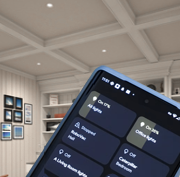Bluetooth Mesh Lighting System Basics
Installation, Usage & Compatibility of Bluetooth Mesh Lighting Systems
Bluetooth Mesh is an extensive computer networking technology that allows communication between ‘many-to-many’ devices. Bluetooth Mesh enables hundreds or thousands of devices to communicate effectively and securely, without any physical connection but within the same network.
Developed in 2017 by Bluetooth SIG, Bluetooth Mesh is a reliable method of sharing information in large networks and has proven especially popular and efficient in controlling large lighting systems. Three components are required to manufacture, install, commission, and control a Bluetooth Mesh lighting system: hardware, firmware, and a software/mobile app.
In this article, the lighting experts at Team Electrical Supply in the Detroit, MI area discuss the components, compatibilities, and advantages of Bluetooth Mesh lighting systems.
Bluetooth Mesh Lighting System Hardware
Bluetooth Mesh lighting systems are operated on ‘System on Chip’ (SoC), an electronic circuit that integrates all – or most – of the components of a computer/electronic system.
Nordic, Infineon, Qualcomm, Silicon Labs, and other major semiconductor companies manufacture Bluetooth Mesh SoC (as well as Bluetooth Mesh Software Development Kit (SDK), sample firmware code, and sample commissioning mobile applications for Android and IOS, and development kits.)
Bluetooth Mesh Lighting System Firmware
Bluetooth SIG has developed specifications for 50+ Bluetooth Mesh ‘Standard Models’ (also called foundation models). Generic models can be used for all types of electronic device functions, including on/off, power level, battery, etc. There are also specific lighting models for luminaries, switches, and sensors that can set various lighting parameters, as well as define light fixture behavior. Device or fixture response to sensors, switches, and scheduling can be programmed into the models.
Most Standard Bluetooth Mesh models provide sufficient capability for establishing the behavior of a robust smart lighting system. Additionally, in cases where Standard Models firmware does not meet all of the systems requirements, a software developer can extend them to fit more exacting lighting control needs.
An additional benefit of Standard Model firmware is that components from the different vendors – luminaries, switches, sensors, etc. – can be mixed and matched to work together.
Bluetooth Mesh Lighting System Software
Bluetooth Mesh Lighting Systems also require software and/or a mobile app to configure and control the network’s devices. For smaller projects, a stand-alone mobile app not linked to back-end cloud software is often sufficient.
For larger commercial Bluetooth Mesh Lighting Systems, a mobile app connected to cloud software with a back-end database is usually required. Commercial customers who need to control multiple Bluetooth Mesh networks can either own, buy, or lease cloud or local network software. This configuration is not only much more secure, but also much more robust than stand-alone mobile apps.
Bluetooth Mesh Lighting Compatibility
Because all Standard Bluetooth Mesh-certified lighting accessories are compatible with each other, users can mix and match lighting fixtures, sensors, switches – and even add HVAC and security systems – into the same Bluetooth Mesh network.
And because of the growing popularity of Bluetooth Mesh Lighting Systems, vendors are also offering many compatible non-Bluetooth Mesh lighting accessories that can be integrated into the Mesh network. This enables users to control both their lighting system and other building smart functions using the same smartphone mobile app.
In May 2020, Bluetooth SIG partnered with the Digital Illumination Interface Alliance (DIIA) to develop a standard uniform interface that would allow luminaries that support DALI protocol to become a part of a Bluetooth Mesh network. Now manufacturers are able to offer products that make DALI-based lighting systems compatible with the Bluetooth Mesh hardware and software, as well.
Bluetooth Mesh Lighting System Advantages
Bluetooth Mesh Lighting Systems offer significant benefits for electrical manufacturers, distributors, builders/installers, and customers.
Bluetooth Mesh Lighting Systems require less wiring and therefore need considerably less labor to install – reducing project costs. Instead of connecting light fixtures to controls via wiring, installers simply add hardware to the network using software and/or a mobile app on a smartphone to connect them. This requires less time and labor, fewer materials, and even less qualification from the installation workers.
And end users, including commercial building managers and tenants, appreciate the ease of control, remote control capability, and energy savings of Mesh Lighting Systems. Additionally, because Mesh enables users to control their lighting network with devices they already have, such as phones and tablets, there is minimal to no investment in controls.
Bluetooth Mesh Lighting System Distribution & Sales
As you can see, the advantages to installing or upgrading to a Bluetooth Mesh Lighting System are many. If you are interested in incorporating a Bluetooth Mesh Lighting System into your next construction project, new build, or upgrade project, the electrical product experts at Team Electrical Sales in the Detroit area are here to help.
At Team Electrical Sales we pride ourselves on representing the highest quality of electrical products and the best customer service in the industry.



